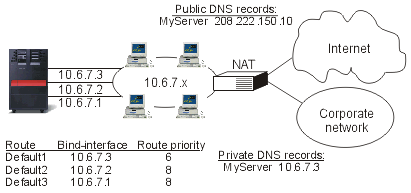Route binding gives you control over which interface is used to send out response packets of information.
Before preferred route binding came along, you did not have complete control over which interface was used to send out response packets of information. The Preferred Route Binding Interface, added to the add route function, gives you more control over which interface is used to send out your packets by allowing you to explicitly bind routes to interfaces.
In the following figure, there are three interfaces connected to the same network. To guarantee that no matter which interface receives the inbound request, the reply can be sent back to the same interface. To do this, you must add the "duplicate" routes to each interface. In this example, three default routes are added, each one is explicitly bound to a different interface. This binding does not change regardless of the order in which interfaces are started or ended.
